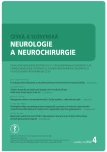Delirium management in neurointensive care in the Czech Republic – a survey
Authors:
L. Hrežová; J. Bednařík
Authors‘ workplace:
Neurologická klinika LF MU a FN Brno
Published in:
Cesk Slov Neurol N 2022; 85(4): 325-329
Category:
Short Communication
doi:
https://doi.org/10.48095/cccsnn2022325
Overview
Delirium is a phenotypic syndrome that is difficult to detect in the intensive care. In neurointensive care, the symptoms of delirium overlap with those of primary brain injury. At the same time, delirium is a predictive factor of higher morbidity and mortality and is often a sign of untreated extracerebral dysfunction or disease like sepsis, metabolic disturbance, and pharmacotherapy combined with immobilization. Thus, the monitoring of delirium in the neurointensive care is an important part of therapy and improvement of patients’ prognosis. Currently, there are validated tests with a relatively high validity and predictive value also in the Czech language. One of the diagnostic pitfalls, so far, is inadequate differential diagnosis of nonconvulsive epileptic status. In the survey, we focused on delirium management in neurointensive care in the Czech Republic. We have found sufficient awareness of the severity of delirium and its other consequences. On the other hand, its systematic monitoring, which is recommended, appears to be a persistent problem in our inpatient care.
Keywords:
stroke – delirium – delirium management
Sources
1. Krewulak KD, Stelfox HT, Leigh JP et al. Incidence and prevalence of delirium subtypes in an adult ICU: a systematic review and meta-analysis. Crit Care Med 2018; 46 (12): 2029–2035. doi: 10.1097/CCM.0000000000003 402.
2. Hshieh TT, Inouye SK, Oh ES. Delirium in the elderly. Clin Geriatr Med 2020; 36 (2): 183–199. doi: 10.1016/j.cger.2019.11.001.
3. Inouye SK, Westendorp RG, Saczynski JS. Delirium in elderly people. Lancet 2014; 383 (9920): 911–922. doi: 10.1016/S0140-6736 (13) 60688-1.
4. Patel MB, Bednarik J, Lee P et al. Delirium monitoring in neurocritically ill patients. Crit Care Med 2018; 46 (11): 1832–1841. doi: 10.1097/CCM.0000000000003349.
5. de la Cruz M, Fan J, Yennu S et al. The frequency of missed delirium in patients referred to palliative care in a comprehensive cancer center. Support Care Cancer 2015; 23 (8): 2427–2433. doi: 10.1007/s00520-015- 2610-3.
6. Salluh JIF, Wang H, Schneider EB et al. Outcome of delirium in critically ill patients: systematic review and meta-analysis. BMJ 2015; 350: h2538–h2538. doi: 10.1136/bmj.h2538.
7. van den Boogaard M, Schoonhoven L, Evers AWM et al. Delirium in critically ill patients: impact on long-term health-related quality of life and cognitive functioning. Crit Care Med 2012; 40 (1): 112–118. doi: 10.1097/CCM.0b 013e31822e9fc9.
8. Barr J, Fraser GL, Puntillo K et al. Clinical practice guidelines for the management of pain, agitation, and delirium in adult patients in the intensive care unit. Crit Care Med 2013; 41 (1): 263–306. doi: 10.1097/CCM. 0b013e3182783b72.
9. Ely EW, Inouye SK, Bernard GR et al. Delirium in mechanically ventilated patients. JAMA 2001; 286 (21): 2703–2710. doi: 10.1001/jama.286.21.2703.
10. Bergeron N, Dubois M-J, Dumont M et al. Intensive care delirium screening checklist: evaluation of a new screening tool. Intensive Care Med 2001; 27 (5): 859–864. doi: 10.1007/s001340100909.
11. Maas M, Naidech A. Critical care neurology perspective on delirium. Semin Neurol 2016; 36 (6): 601–606. doi: 10.1055/s-0036-1592318.
12. Ely EW, Truman B, Shintani A et al. Monitoring sedation status over time in ICU patients: reliability and validity of the Richmond Agitation-Sedation Scale (RASS). JAMA 2003; 289 (22): 2983–2991. doi: 10.1001/jama.289.22. 2983.
13. Mitasova A, Kostalova M, Bednarik J et al. Poststroke delirium incidence and outcomes: validation of the Confusion Assessment Method for the Intensive Care Unit (CAM-ICU). Crit Care Med 2012; 40 (2): 484–490. doi: 10.1097/CCM.0b013e318232da12.
14. Reznik ME, Drake J, Margolis SA et al. Deconstructing poststroke delirium in a prospective cohort of patients with intracerebral hemorrhage. Crit Care Med 2020; 48 (1): 111–118. doi: 10.1097/CCM.0000000000004031.
15. Hrežová L, Bednařík J. Diagnostika deliria v akutní fázi iktu. Cesk Slov Neurol N 2021; 84/117 (Suppl 1): S64.
16. Dahl MH, Rønning OM, Thommessen B. Delirium in acute stroke – prevalence and risk factors: delirium in acute stroke. Acta Neurol Scand Suppl 2010; 122 (190): 39–43. doi: 10.1111/j.1600-0404.2010.01374.x.
17. Shi Q, Presutti R, Selchen D et al. Delirium in acute stroke: a systematic review and meta-analysis. Stroke 2012; 43 (3): 645–659. doi: 10.1161/STROKEAHA.111.643726.
18. Marra A, Ely EW, Pandharipande PP et al. The ABCDEF bundle in critical care. Crit Care Clin 2017; 33 (2): 225–243. doi: 10.1016/j.ccc.2016.12.005.
19. American Geriatrics Society Expert Panel on Postoperative Delirium in Older Adults. American Geriatrics Society abstracted clinical practice guideline for postoperative delirium in older adults. J Am Geriatr Soc 2015; 63 (1): 142–150. doi: 10.1111/jgs.13281.
20. Holtkamp M, Meierkord H. Nonconvulsive status epilepticus: a diagnostic and therapeutic challenge in the intensive care setting. Ther Adv Neurol Disord 2011; 4 (3): 169–181. doi: 10.1177/1756285611403826.
Labels
Paediatric neurology Neurosurgery NeurologyArticle was published in
Czech and Slovak Neurology and Neurosurgery

2022 Issue 4
Most read in this issue
- Validation of questionnaire for evaluation of ischemic stroke sequels – the Czech version of Stroke Impact Scale 3.0
- Telemedical assessments by remote versions of ALBA, POBAV and ACE-III tests
- Pathological magnetic resonance imaging findings in myelin oligodendrocyte glycoprotein antibody-associated disease
- Dabigatran pharmacogenetics and secondary prevention of ischemic stroke
